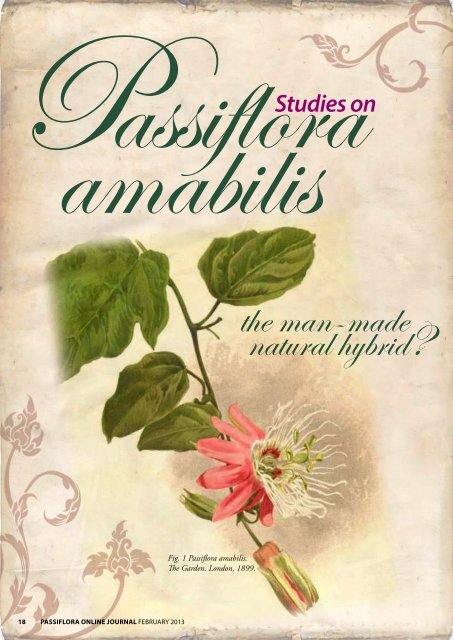Issue 3 2013 Lo-res PDF - Passion Flowers
Issue 3 2013 Lo-res PDF - Passion Flowers
Issue 3 2013 Lo-res PDF - Passion Flowers
Create successful ePaper yourself
Turn your PDF publications into a flip-book with our unique Google optimized e-Paper software.
Passiflora<br />
Studies on<br />
amabilis<br />
Red flowered Passiflora are very popular with<br />
growers as they are so striking and P. amabilis<br />
fits the bill perfectly. The beautiful bright red<br />
flowers have a large white corona with a touch<br />
of purple, complimented by a sweet scent making it a<br />
must have for every Passiflora fanatic. The large green vine,<br />
with its nice ovate-lanceolate green leaves and easy flower<br />
production make P. amabilis a valued specimen for every<br />
botanical or private collection... but why has no one ever<br />
heard of it?<br />
P. amabilis is a complicated species<br />
which is actually nearer to home than<br />
most Passiflora enthusiasts imagine.<br />
“The original description of the<br />
species was made by Andre Guillemin<br />
in 1846, and reads as follows.”<br />
Passiflora Online Journal February <strong>2013</strong><br />
19<br />
white to whitish, seeds black.<br />
In both the works of Killip and of Lemaire this species is stated<br />
as a horticultural hybrid between P. princeps (P. racemosa) and<br />
P. alata. Dr. C.S. Suckati (1953) reported specimens of<br />
P. amabilis in the wild from Parque Nacional da Tijuca and<br />
Morro da Caixa Dagua, two closely located fo<strong>res</strong>ts surrounding<br />
Rio de Janeiro in Southern Brazil. This is also the home of<br />
the purported parent species, P. racemosa and P. alata. Both<br />
Masters (Flora Brasiliensis 1872) and Harms (Naturlichen<br />
Pflanzenfamilien 1893) mentioned Southern Brazil as the<br />
indigenous distribution area of P. amabilis. However, without<br />
Fig. 1 Passiflora amabilis.<br />
The Garden. <strong>Lo</strong>ndon, 1899.<br />
the man-made<br />
natural hybrid?<br />
Passiflora AMABILIS hort. ex Lem.<br />
Flore des Ser<strong>res</strong> et des Jardins de<br />
l’Europe 3:209. March 1847 TYPE: The<br />
species is described from a cultivated<br />
specimens. Cote d’Azur, April 1846,<br />
Andre Guillemin (HOLOTYPE: US;<br />
isotypes: MO, KEW)<br />
Plant glabrous throughout; stem very<br />
slender, terete or subterete; stipules<br />
ovate-lanceolate, about 1,5 cm long, 2<br />
to 3 mm wide, acuminate, subfalcate,<br />
soon deciduous; petioles slender, 1,5 to<br />
4 cm long, bearing 1 or 2 pairs of sessile<br />
glands; leaves ovate-oblong or ovate-lanceolate, 7 to 12 cm<br />
long, 4 to 9 cm wide, acute, entire, subcordate, penninerved or<br />
subtrinerved, membranous; peduncles solitary, 3 to 4 cm long;<br />
bracts ovate, about 2 cm long and 1,5 cm wide, borne at the<br />
base of the flower; flowers spectacular, 8 to 9 cm in diameter, red<br />
with white; calyx tube short-tubular, about 1,5 cm long and 1,5<br />
cm wide at the throat; sepals linear-oblong or linear-lanceolate,<br />
about 3,5 cm long and 1 cm wide, dorsally short-awned,<br />
bright red within, whitish red to green without; petals subequal<br />
to the sepals, 3,4-3,3 cm long, 0,8 to 0,9 cm wide, bright<br />
red throughout and on both surfaces; corona in three series,<br />
the outermost series 2,5 to 3 cm long, radiate, occassionally<br />
slightly dolabriform and wavy at apex, white to whitish cream,<br />
with little purplish tint in apical third; the second series about<br />
1 to 1,2 cm, erect, slightly liguliform, white to whitish cream<br />
throughout; the innermost series inclined, about 1,5 cm<br />
long, white; operculum erect, about 6 mm high, obscurely<br />
filamentose at the very margin; limen erect, minute, about 4<br />
mm high, closely surrounding the androgynophore, 5-dentate;<br />
androgynophore long, 3,5 to 4 cm, green throughout; anthers<br />
greenish yellow; ovary ellipsoid, green, glabrous; stamen green;<br />
fruit green to greenish yellow when mature, 3-3,5 x 4,5-5,5 cm,<br />
ellipsoid to ovoid, glabrous, exocarp coriaceous, mesocarp soft,<br />
Fig. 2 Passiflora amabilis.<br />
© 2011 Yero Kuethe<br />
good cultivated specimens or more detailed information about<br />
a living population, P. amabilis remains a mystery.<br />
Unfortunately, P. amabilis disappeared into the background<br />
and remained un<strong>res</strong>olved for a long time. Then, in<br />
2003, this species showed up again, and this time in<br />
cultivation. Most surprisingly, it wasn’t a specimen which<br />
came from a population in its indigenous habitat. Piet<br />
Moerman, Passiflora expert from the PassifloraHoeve<br />
in The Netherlands, succeeded in crossing<br />
P. racemosa and P. alata, the purported parents<br />
of P. amabilis, producing a hybrid he called<br />
P. ‘Wilgen Heintje’. This hybrid is now<br />
very popular in cultivation, and can be<br />
found in many private and<br />
botanical collections. With<br />
the right treatment, fruits<br />
with fertile offspring<br />
can be produced as<br />
well. Therefore, it<br />
is more than likely<br />
that P. amabilis is a<br />
phylogenetic <strong>res</strong>ult<br />
18<br />
Passiflora Online Journal February <strong>2013</strong>
















